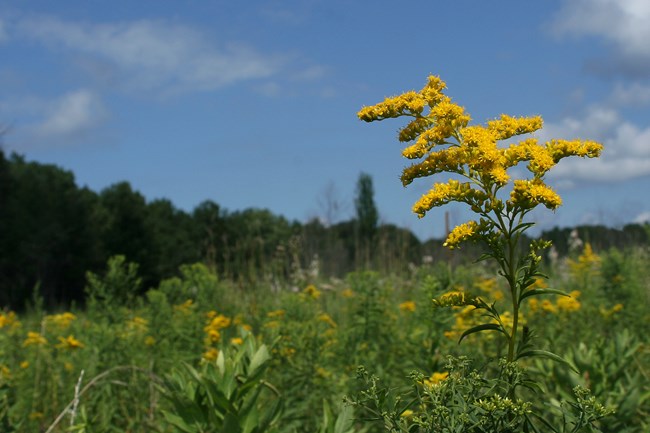Last updated: October 1, 2021
Article
Sunshine Flowers of Fall

NPS Staff / Katrina George
Goldenrods are often accused of causing hay fever, which one of my neighbors mistakenly pointed out to me. The culprit is more likely common ragweed, which does often grow alongside goldenrod, and would be blooming at the same time in my yard had I not been pulling it. Ragweed is dispersed by the wind and thus bothers my neighbor’s allergies. Solidagos, the Latin name for the goldenrod family, is pollinated by insects and they spread by seeds and underground rhizomes.
There are over 100 species of Goldenrods in the United States, especially in the east. They are in the sunflower family (Asteracae) and the Indiana Dunes has many of them growing throughout the park. Some of the names are self-explanatory, such as early goldenrod blooming earlier than others, late goldenrod persisting until the first frost, and old-field goldenrod growing in old fields. Others like Ohio goldenrod and bog goldenrod note where they are commonly found.
At least 18 different species of solidago have been chronicled in the national and state parks. Like many species in the dunes, virtually every habitat has its own goldenrods. Tall and Canada goldenrods are hearty and can thrive in degraded habitats while swamp goldenrods are found only along the borders of particular wetlands. I enjoy showy goldenrod, abundant near my office in the oak savanna habitat of Miller Woods. These late blooming flowers are an important source of energy to pollinators like butterflies, bees and wasps and are needed by monarch butterflies during their arduous migration to Mexico.
Join a park ranger for our weekly Sunday afternoon Miller Woods hikes at 1:30 pm meeting at the Douglas Center for Environmental Education. September and October is the time to appreciate these sunshiny flowers brightening your trail.
Article by Indiana Dunes Park Ranger Julie Larsen
